Projection of the Co-Reduced Emissions of CO2 and Air Pollutants from Civil Aviation in China
Abstract
1. Introduction
2. Materials and Methods
2.1. Calculation Methods
2.2. Data Sources
2.2.1. Activity Level Data
2.2.2. Emission Factors
2.3. Scenario Defined
2.3.1. Baseline Scenario
2.3.2. General Scenario
2.3.3. Stringent Scenario
2.4. Projection of CO2 and Air Pollutant Emissions from the Aviation Sector
2.4.1. Projection of Emissions during the LTO Phase
2.4.2. Projection of Emissions during the Cruise Phase
2.5. Co-Reduction of Emissions
3. Results and Discussions
3.1. Present Emissions from the Aviation Sector
3.2. CO2 and Pollutant Emission Projections
3.2.1. LTO Cycles
3.2.2. Emissions Projections
3.3. Analysis of Multi-Pollutant Reduction Potential under Different Scenarios
3.3.1. Emissions Projections
- (1)
- Baseline scenario
- (2)
- General scenario
- (3)
- Stringent scenario
3.3.2. Emission Reduction Potential
- (1)
- CO2 reduction Potential
- (2)
- Air pollutants reduction potential
3.4. Co-Reduced Effect of CO2 and Air Pollutants
4. Conclusions and Recommendations
Author Contributions
Funding
Institutional Review Board Statement
Informed Consent Statement
Data Availability Statement
Acknowledgments
Conflicts of Interest
Abbreviation
| Word (s) | Abbreviation |
| carbon dioxide | CO2 |
| nitrogen oxides | NOx |
| sulfur dioxide | SO2 |
| carbon monoxide | CO |
| particulate matter | PM |
| hydrocarbons | HC |
| landing and takeoff | LTO |
| Geographic Information Systems | GIS |
| Autoregressive Integrated Moving Average | ARIMA |
| International Civil Aviation Organization | ICAO |
| Civil Aviation Administration of China | CAAC |
| Fuel Sulfur Content | FSC |
| National Aeronautics and Space Administration | NASA |
| International Energy Agency | IEA |
| Revenue Passenger Kilometer | RPK |
| Aviation Industry Development Research Center | ADR |
| Chinese Academy of Social Sciences | CASS |
| General Electric Company | GE |
References
- Zhou, W.; Wang, T.; Yu, Y.; Chen, D.; Zhu, B. Scenario analysis of CO2 emissions from China’s civil aviation industry through 2030. Appl. Energy 2016, 175, 100–108. [Google Scholar] [CrossRef]
- Han, R.; Li, L.; Zhang, X.; Lu, Z.; Zhu, S. Spatial-temporal Evolution Characteristics and Decoupling Analysis of Influencing Factors of China’s Aviation Carbon Emissions. Chin. Geogr. Sci. 2022, 32, 218–236. [Google Scholar] [CrossRef]
- International Council on Clean Transportation (ICCT). Available online: https://theicct.org/publication/co2-emissions-from-commercial-aviation-2018/ (accessed on 24 November 2022).
- Environmental Defense Fund. Available online: http://www.cet.net.cn/html/news/CET/2020/0608/437.html (accessed on 24 November 2022). (In Chinese).
- Yim, S.H.; Lee, G.L.; Lee, I.H.; Allroggen, F.; Ashok, A.; Caiazzo, F.; Eastham, S.D.; Malina, R.; Barrett, S.R. Global, regional and local health impacts of civil aviation emissions. Environ. Res. Lett. 2015, 10, 034001. [Google Scholar] [CrossRef]
- Nascimento, B.N.O.; Lorena, D.C.G.D.; Tureta, Z.I. Evaluation of energy consumption and emissions of carbon dioxide of road transport of Brazil (2016–2026). Desenvolv. E Meio Ambiente 2020, 54, 22. [Google Scholar] [CrossRef]
- Bebkiewicz, K.; Chłopek, Z.; Lasocki, J.; Szczepański, K.; Zimakowska-Laskowska, M. The Inventory of Pollutants Hazardous to the Health of Living Organisms, Emitted by Road Transport in Poland between 1990 and 2017. Sustainability 2020, 12, 5387. [Google Scholar] [CrossRef]
- Liu, G.; Sun, S.; Zou, C.; Wang, B.; Wu, L.; Mao, H. Air pollutant emissions from on-road vehicles and their control in Inner Mongolia, China. Energy 2022, 238, 121724. [Google Scholar] [CrossRef]
- Wang, J.; Li, Y.; Zhang, Y. Research on Carbon Emissions of Road Traffic in Chengdu City Based on a LEAP Model. Sustainability 2022, 14, 5625. [Google Scholar] [CrossRef]
- Zhang, W.; Cao, S.Y.; Gu, Y.F. Reduction Potential of Carbon Emission from Inland Water Transportation Activities of Jiangxi Province. In Advanced Materials Research; Trans Tech Publications: Wollerau, Switzerland, 2012; Volume 524, pp. 3651–3654. [Google Scholar] [CrossRef]
- Andreoni, V.; Galmarini, S. European CO2 emission trends: A decomposition analysis for water and aviation transport sectors. Energy 2012, 45, 595–602. [Google Scholar] [CrossRef]
- Xu, X.; Kent, S.; Schmid, F. Carbon-reduction potential of electrification on China’s railway transport: An analysis of three possible future scenarios. Proc. Inst. Mech. Eng. Part F J. Rail Rapid Transit 2021, 235, 226–235. [Google Scholar] [CrossRef]
- Dincer, F.; Elbir, T. Estimating national exhaust emissions from railway vehicles in Turkey. Sci. Total Environ. 2007, 374, 127–134. [Google Scholar] [CrossRef]
- Simone, N.W.; Stettler, M.E.J.; Barrett, S.R.H. Rapid estimation of global civil aviation emissions with uncertainty quantification. Transp. Res. Part D: Transp. Environ. 2013, 25, 33–41. [Google Scholar] [CrossRef]
- Lyu, C.; Liu, X.; Wang, Z.; Yang, L.; Liu, H.; Yang, N.; Xu, S.; Cao, L.; Zhang, Z.; Pang, L.; et al. An emissions inventory using flight information reveals the long-term changes of aviation CO2 emissions in China. Energy 2023, 262, 125513. [Google Scholar] [CrossRef]
- Yu, J.; Shao, C.; Xue, C.; Hu, H. China’s aircraft-related CO2 emissions: Decomposition analysis, decoupling status, and future trends. Energy Policy 2020, 138, 111215. [Google Scholar] [CrossRef]
- Zeydan, O.; Sekertekin, Y.Y. GIS-based determination of Turkish domestic flights emissions. Atmos. Pollut. Res. 2022, 13, 101299. [Google Scholar] [CrossRef]
- Zhou, Y.; Jiao, Y.; Lang, J.; Chen, D.; Huang, C.; Wei, P.; Li, S.; Cheng, S. Improved estimation of air pollutant emissions from landing and takeoff cycles of civil aircraft in China. Environ. Pollut. 2019, 249, 463–471. [Google Scholar] [CrossRef]
- Tokuslu, A. Estimation of aircraft emissions at Georgian international airport. Energy 2020, 206, 118219. [Google Scholar] [CrossRef]
- Wang, M.X. Analysis to the Technology Path on Zero-Emission Aviation. ADR 2021, 18, 16–19. (In Chinese) [Google Scholar]
- Irving, M. Biofuels Can Slash Aircraft Particle Emissions and Reduce Contrails. Available online: https://newatlas.com/nasa-biofuel-impact-study-contrails/48433/ (accessed on 24 November 2022).
- Wise, M.; Muratori, M.; Kyle, P. Biojet fuels and emissions mitigation in aviation: An integrated assessment modeling analysis. Transp. Res. Part D-Transp. Environ. 2017, 52, 244–253. [Google Scholar] [CrossRef]
- Hassan, M.; Pfaender, H.; Mavris, D. Probabilistic assessment of aviation CO2 emission targets. Transp. Res. Part D-Transp. Environ. 2018, 63, 362–376. [Google Scholar] [CrossRef]
- Bicer, Y.; Dincer, I. Life cycle evaluation of hydrogen and other potential fuels for aircrafts. Int. J. Hydrogen Energy 2017, 42, 10722–10738. [Google Scholar] [CrossRef]
- Khalili, M.; Ali Dashtaki, M.; Nasab, M.A.; Reza Hanif, H.; Padmanaban, S.; Khan, B. Optimal instantaneous prediction of voltage instability due to transient faults in power networks taking into account the dynamic effect of generators. Cogent Eng. 2022, 9, 2072568. [Google Scholar] [CrossRef]
- Padmanaban, S.; Samavat, T.; Nasab, M.A.; Nasab, M.A.; Zand, M.; Nikokar, F. Electric Vehicles and IoT in Smart Cities. In Artificial Intelligence-Based Smart Power Systems; John Wiley & Sons, Inc.: New York, NY, USA, 2022; pp. 273–290. [Google Scholar] [CrossRef]
- Puliafito, S.E. Civil aviation emissions in Argentina. Sci. Total Environ. 2023, 869, 161675. [Google Scholar] [CrossRef] [PubMed]
- Liu, H.; Tian, H.; Hao, Y.; Liu, S.; Liu, X.; Zhu, C.; Wu, Y.; Liu, W.; Bai, X.; Wu, B. Atmospheric emission inventory of multiple pollutants from civil aviation in China: Temporal trend, spatial distribution characteristics and emission features analysis. Sci. Total Environ. 2019, 648, 871–879. [Google Scholar] [CrossRef] [PubMed]
- Van Pham, V.; Tang, J.; Alam, S.; Lokan, C.; Abbass, H.A. Aviation emission inventory development and analysis. Environ. Model. Softw. 2010, 25, 1738–1753. [Google Scholar] [CrossRef]
- Dmitrieva, T.M.; Grabar, V.A. Emissions from Russian domestic civil aviation in 2000–2012 and integrated assessment of their impact on the climate system. Russ. Meteorol. Hydrol. 2017, 42, 538–543. [Google Scholar] [CrossRef]
- Yang, H.J.; O’Connell, J.F. Short-term carbon emissions forecast for aviation industry in Shanghai. J. Clean. Prod. 2020, 275, 122734. [Google Scholar] [CrossRef]
- Owen, B.; Lee, D.S.; Lim, L. Flying into the future: Aviation emissions scenarios to 2050. Environ. Sci. Technol. 2010, 44, 2255–2260. [Google Scholar] [CrossRef]
- Schaefer, M. Forecast of air traffic’s CO2 and NOx emissions until 2030. Int. J. Aviat. Manag. 2015, 2, 256–273. [Google Scholar] [CrossRef]
- ICAO. International Standards and Recommended Practices, Environmental Protection Annex 16. Volume II Aircraft Engine Emissions, Second Ed. 1993. Available online: https://www.icao.int/environmental-protection/Documents/EnvironmentalReports/2022/ENVReport2022_Art17.pdf#search=International%20Standards%20and%20Recommended%20Practices%2C%20Environmental%20Protection%20Annex%2016%2E%20Volume%20II%20aircraft%20engine%20emissions (accessed on 20 April 2023).
- ICAO. Airport Air Quality Manual. 2016. Available online: https://www.icao.int/environmental-protection/Documents/Doc%209889.SGAR.WG2.Initial%20Update.pdf#search=operational%20LTO%20flight%20cycle%20 (accessed on 20 April 2023).
- Civil Aviation Administration of China. Statistical Data on Civil Aviation of China 2019; Civil Aviation Press of China: Beijing, China, 2020. Available online: http://www.caac.gov.cn/XWZX/MHYW/202006/P020200608350035195085.pdf (accessed on 20 April 2023). (In Chinese)
- Wayson, R.L.; Fleming, G.G.; Iovinelli, R. Methodology to Estimate Particulate Matter Emissions from Certified Commercial Aircraft Engines. J. Air Waste Manag. Assoc. 2009, 59, 91–100. [Google Scholar] [CrossRef]
- Wei, Z.Q.; Diao, H.Z.; Han, B. Research on calculating aircraft pollution emissions in cruise phase. Sci. Technol. Eng. 2014, 14, 122–127. (In Chinese) [Google Scholar] [CrossRef]
- Han, B.; Liu, Y.T.; Tan, H.Z.; Wang, Y.; Wei, Z.Q. Emission characterization of civil aviation aircraft during a whole flight. Acta Sci. Circumstantiae 2017, 37, 4492–4502. (In Chinese) [Google Scholar] [CrossRef]
- EEA. EMEP/EEA Air Pollutant Emission Inventory Guidebook 2019. Available online: https://www.eea.europa.eu/publications/emep-eea-guidebook-2019 (accessed on 24 November 2022).
- GB6537-2018; Jet fuel No.3; China Standard Press: Beijing, China, 2018.
- Schumann, U.; Arnold, F.; Busen, R.; Curtius, J.; Kärcher, B.; Kiendler, A.; Petzold, A.; Schlager, H.; Schröder, F.; Wohlfrom, K.H. Influence of fuel sulfur on the composition of aircraft exhaust plumes: The experiments SULFUR 1–7. J. Geophys. Res. Atmos. 2002, 107, AAC 2–1–AAC 2–27. [Google Scholar] [CrossRef]
- Li, C. Emissions Characteristics and Future Trends of Non-Road Mobile Sources in China. Ph.D. Thesis, South China University of Technology, Guangzhou, China, 2017. (In Chinese). [Google Scholar]
- Airbus. Global Market Forecast 2019–2038. Available online: https://www.britishaviationgroup.co.uk/news/airbus-global-market-forecast-2019-2038/ (accessed on 24 November 2022).
- Aviation Industry Releases Annual Report on Civil Aircraft China Market Forecast 2020–2039. 2020. Available online: http://www.textsharefiledownload.com/downloads1.asp?f=0420/638176296347139201.PDF (accessed on 20 April 2023). (In Chinese).
- Central People’s Government of the PRC. Outline of the Fourteenth Five-Year Plan for National Economic and Social Development of the PRC and Vision 2035. Available online: http://www.gov.cn/xinwen/2021-03/13/content_5592681.htm (accessed on 24 November 2022).
- Chinese Academy of Social Sciences. Economic Blue Book: Analysis and Forecast of China’s Economic Situation in 2021; Social Science Literature Press: Beijing, China, 2021. [Google Scholar]
- IEA. World Energy Outlook 2020. Available online: https://www.iea.org/reports/world-energy-outlook-2020 (accessed on 24 November 2022).
- IPCC. IPCC Guidelines for National Greenhouse Gas Inventories. Available online: https://www.ipcc.ch/report/2006-ipcc-guidelines-for-national-greenhouse-gas-inventories/ (accessed on 24 November 2022).
- Yu, J.L.; Gao, C.; Hu, H.Q. Characteristics of temporal and spatial distribution of air pollutant emissions from civil aviation aircrafts in mainland China. China Transp. Rev. 2019, 41, 70–75. (In Chinese) [Google Scholar]
- Xiurui, G.; Xiaoqian, G.; Yao, L.; Yiling, Z. Projections of the Emission Reductions of Carbon Dioxide and Conventional Pollutants in the Major Transport Sectors of the Beijing-Tianjin-Hebei Region, China. J. Resour. Ecol. 2023, 14, 372–382. [Google Scholar] [CrossRef]
- Mao, X.Q.; Xing, Y.K.; Gao, Y.B.; Feng, H.; An, Z.; Peng, K.; Tao, H. Study on GHGs and air pollutants co-control: Assessment and planning. China Environ. Sci. 2021, 41, 3390–3398. (In Chinese) [Google Scholar]
- Wang, Q.Y. Textbook of Energy Data 2019; Innovative Green Development Program: Beijing, China, 2019; p. 51. (In Chinese) [Google Scholar]
- Ministry of Ecology and Environment of the People’s Republic of China. Annual Report on Environmental Management of Mobile Sources in China. 2019. Available online: https://www.mee.gov.cn/xxgk2018/xxgk/xxgk15/201909/t20190904_732374.html (accessed on 24 November 2022).
- Zand, M.; Nasab, M.A.; Hatami, A.; Kargar, M.; Chamorro, H.R. Using Adaptive Fuzzy Logic for Intelligent Energy Management in Hybrid Vehicles. In Proceedings of the 28th Iranian Conference on Electrical Engineering (ICEE), Tabriz, Iran, 4–6 August 2020. [Google Scholar]
- Fan, W.; Sun, Y.; Zhu, T.; Wen, Y. Emissions of HC, CO, NOx, CO2, and SO2 from civil aviation in China in 2010. Atmos. Environ. 2012, 56, 52–57. [Google Scholar] [CrossRef]
- Fei, W.P.; Xiong, L.L.; Bian, X.H.; Song, G.H. Calculation and prediction analysis of air pollutant of civil aviation aircraft in China. J. Transp. Syst. Eng. Inf. Technol. 2020, 20, 33–40. (In Chinese) [Google Scholar] [CrossRef]
- Yu, J.L.; Jia, Q.; Gao, C.; Hu, H.Q. Air pollutant emissions from aircraft landing and take-off cycles at Chinese airports. Aeronaut. J. 2021, 125, 578–592. [Google Scholar] [CrossRef]
- Christodoulakis, J.; Karinou, F.; Kelemen, M.; Kouremadas, G.; Fotaki, E.F.; Varotsos, C.A. Assessment of air pollution from Athens International Airport and suggestions for adaptation to new aviation emissions restrictions. Atmos. Pollut. Res. 2022, 13, 101441. [Google Scholar] [CrossRef]
- Taghizadeh, S.A.; Shafabakhsh, G.H.; Aghayan, I. Evaluation of aircraft emission at Imam Khomeini International Airport and Mehrabad International Airport. Int. J. Environ. Sci. Technol. 2019, 16, 6587–6598. [Google Scholar] [CrossRef]
- Ekici, S.; Sevinc, H. Understanding a commercial airline company: A case study on emissions and air quality costs. Int. J. Environ. Sci. Technol. 2022, 19, 5139–5154. [Google Scholar] [CrossRef]
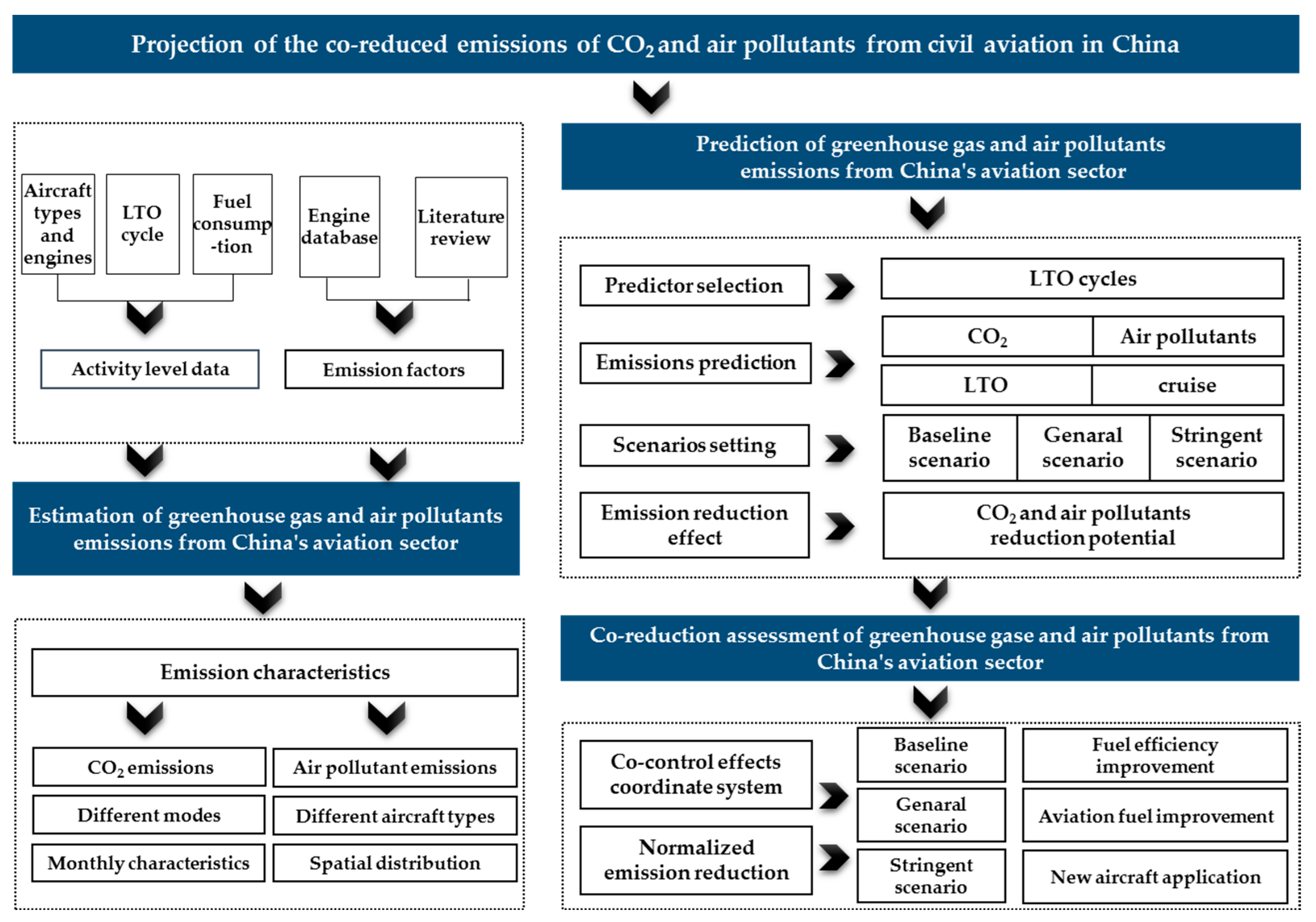


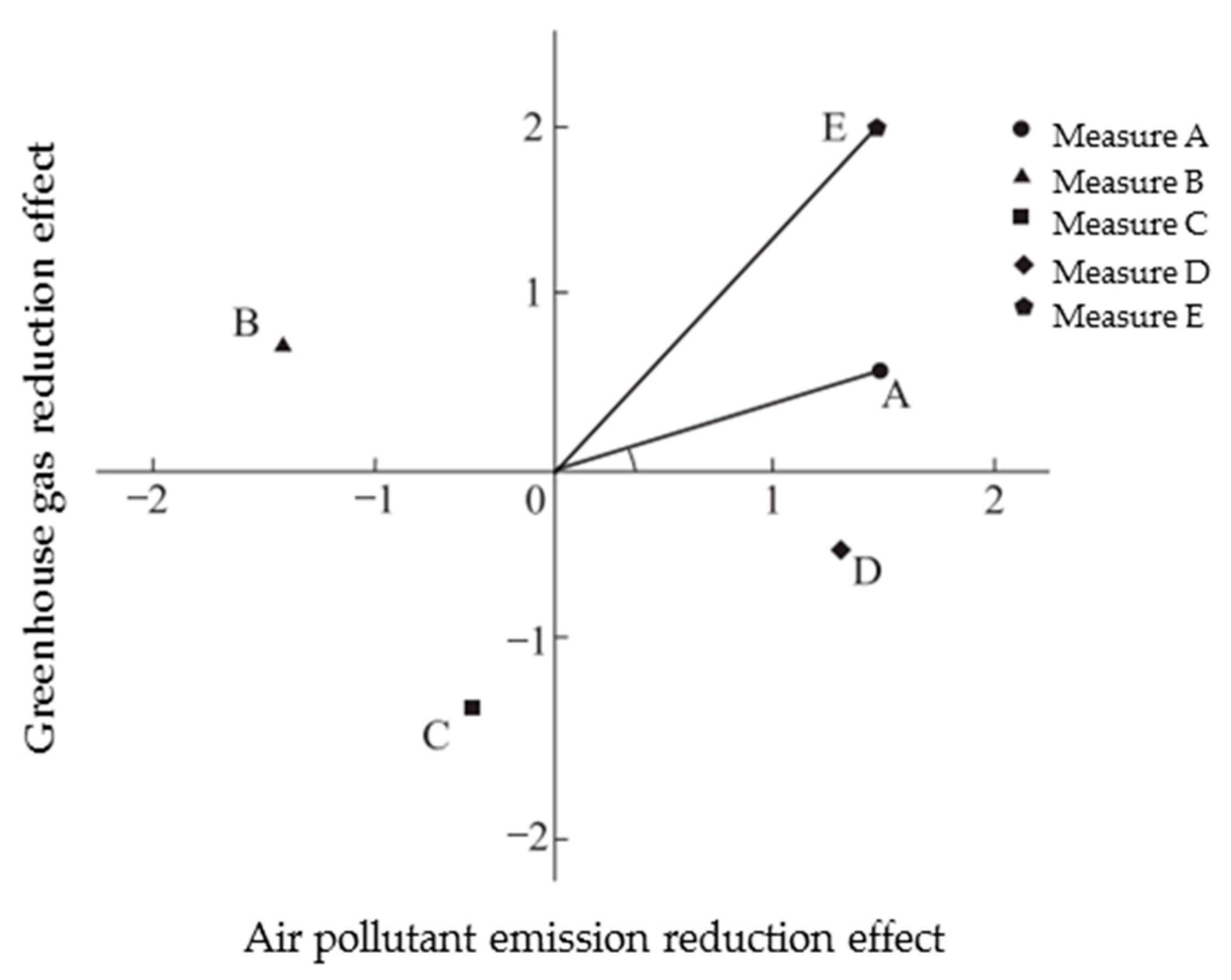
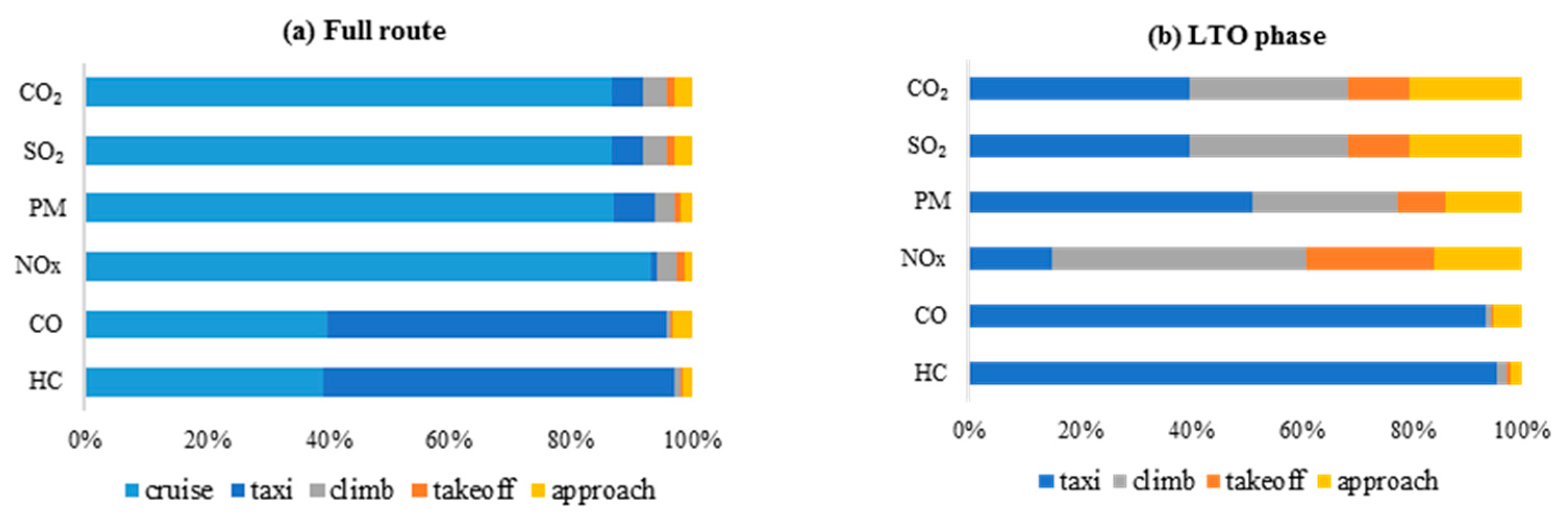
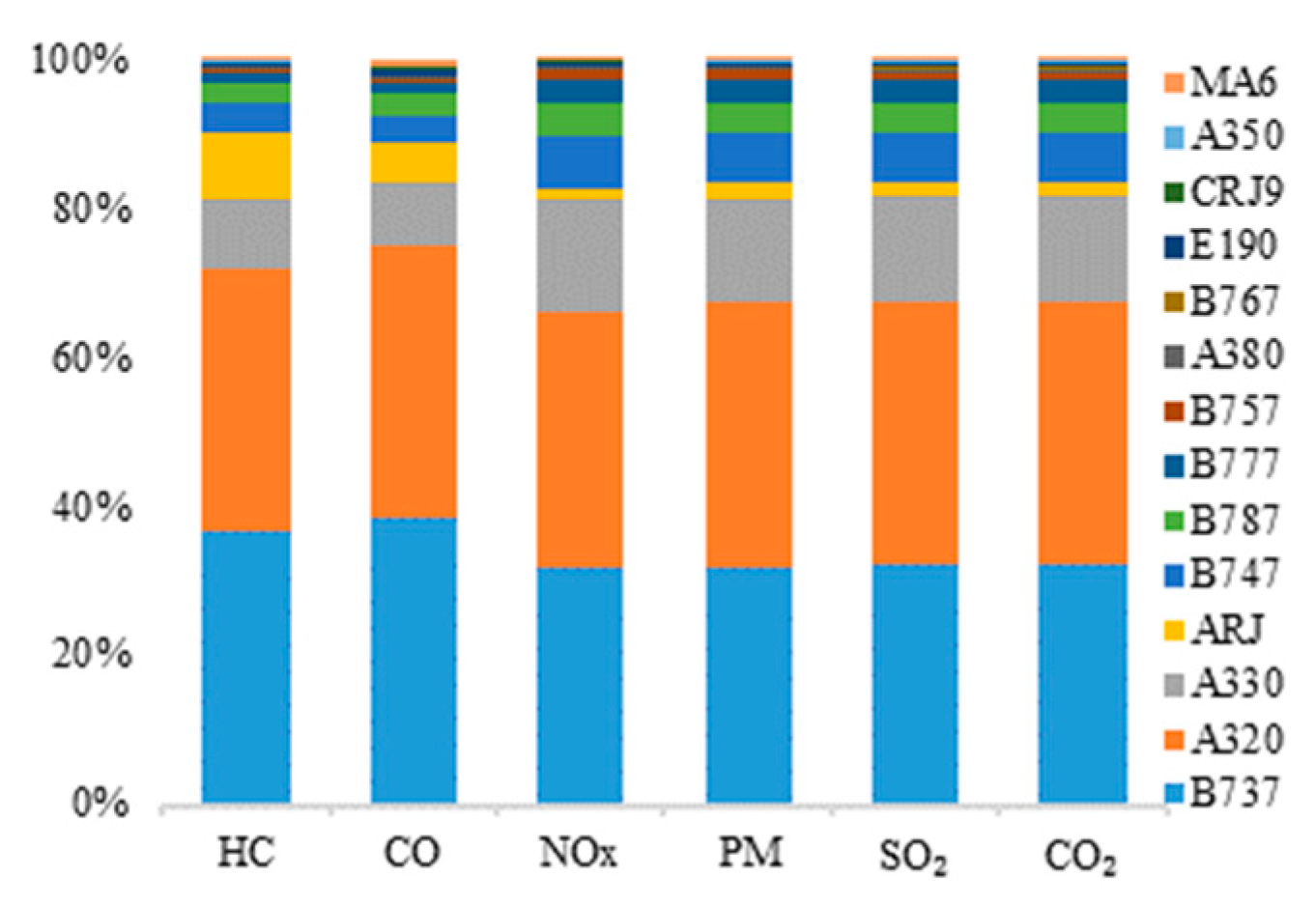
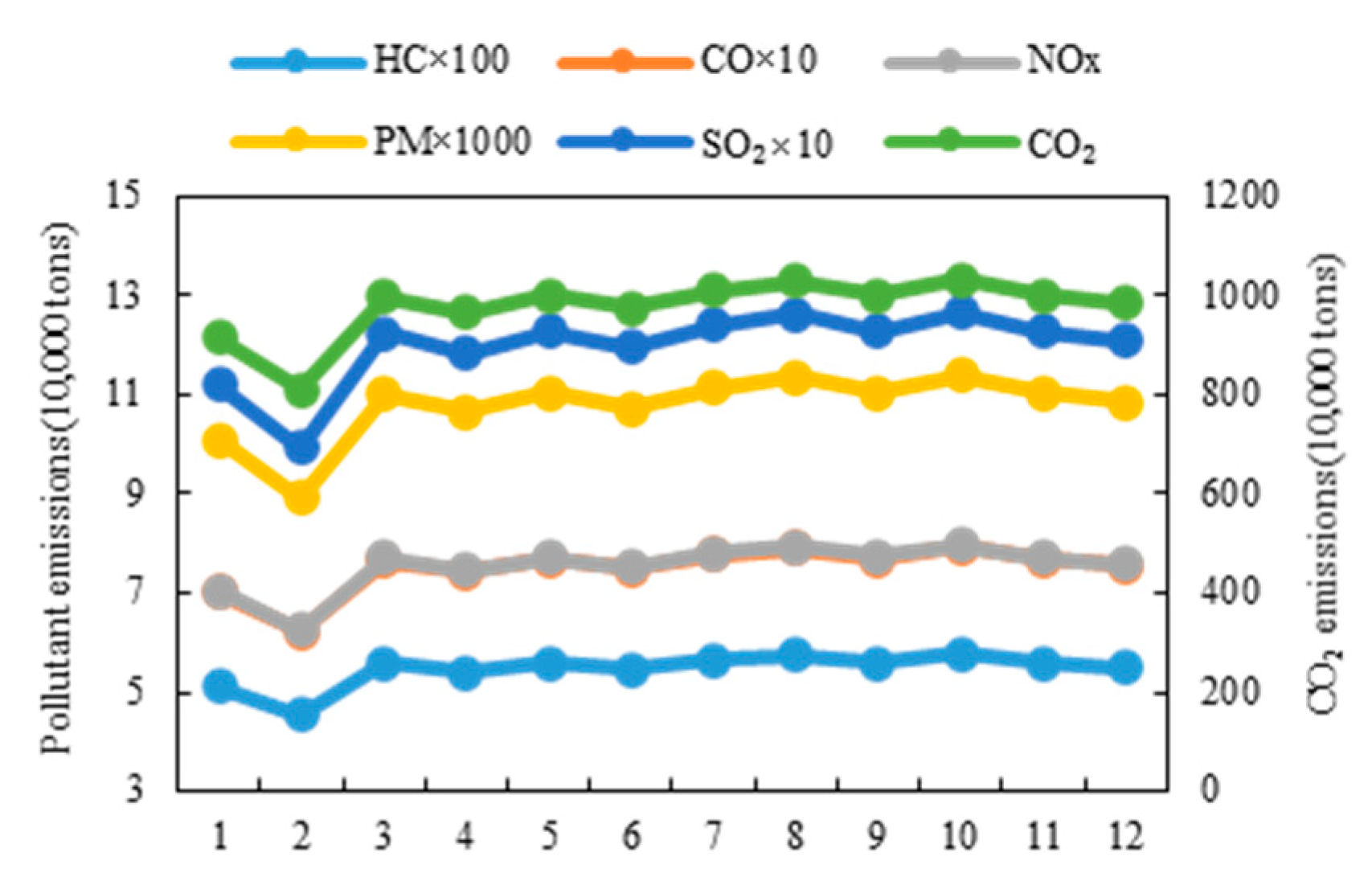
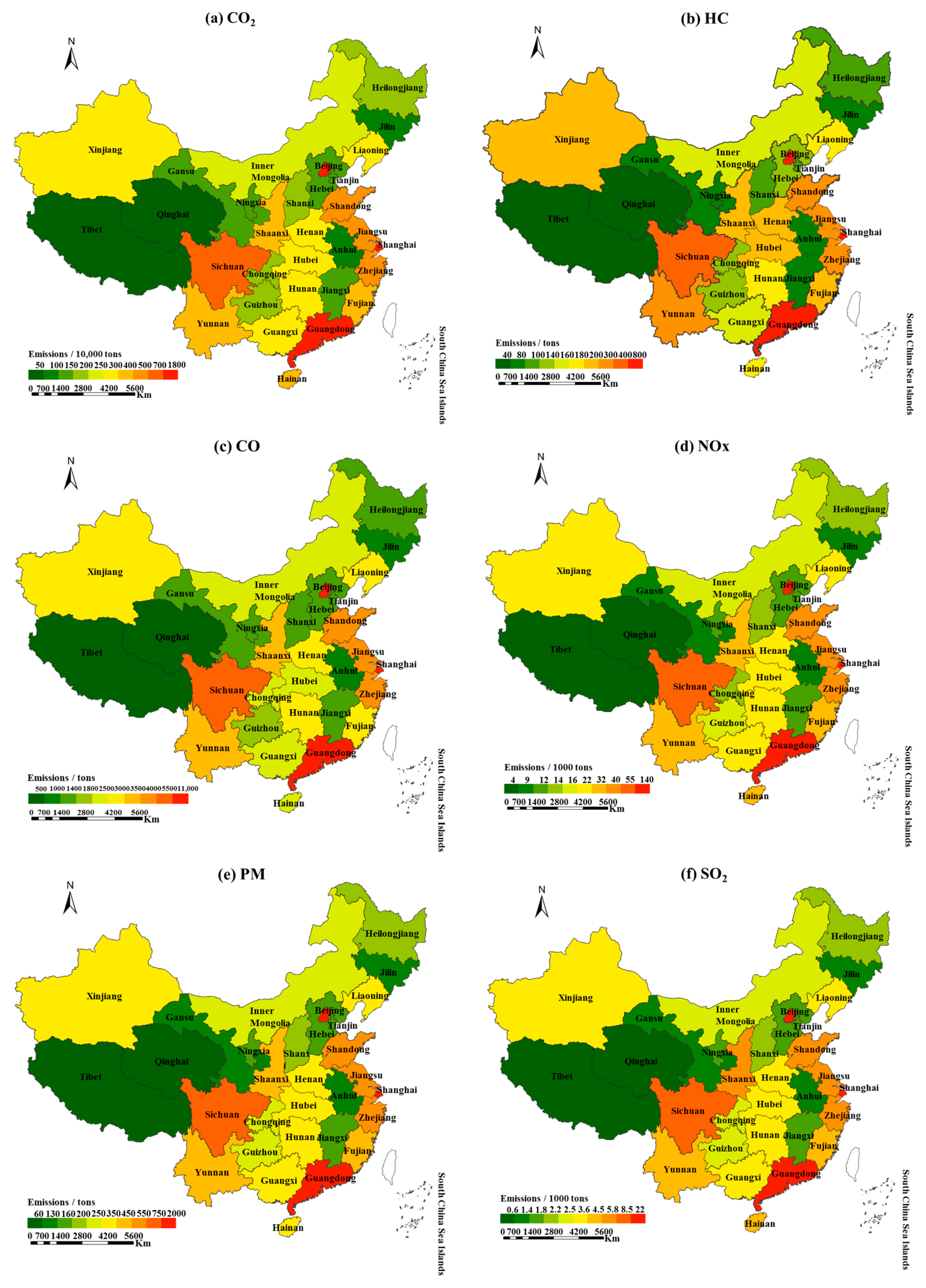
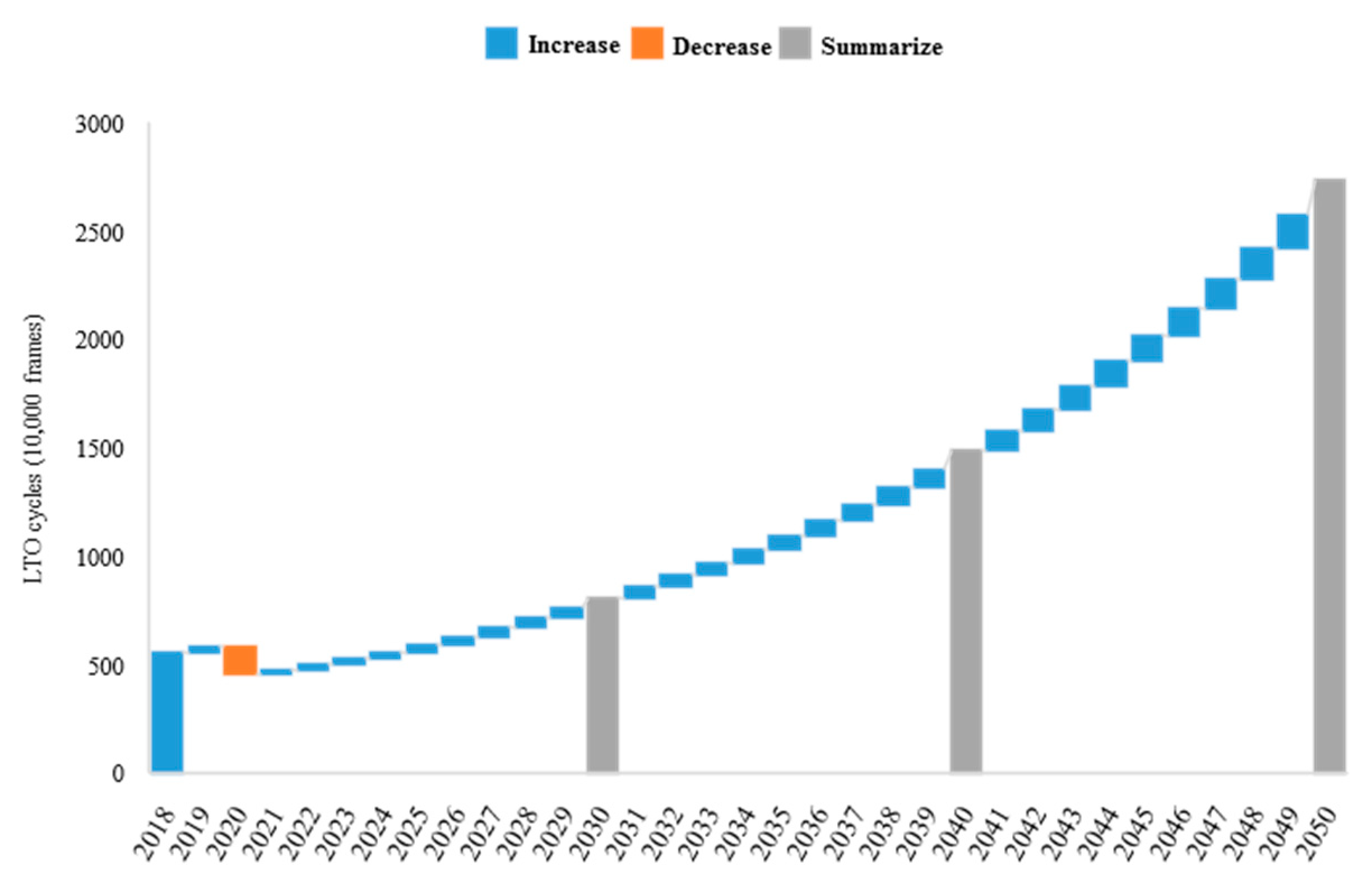
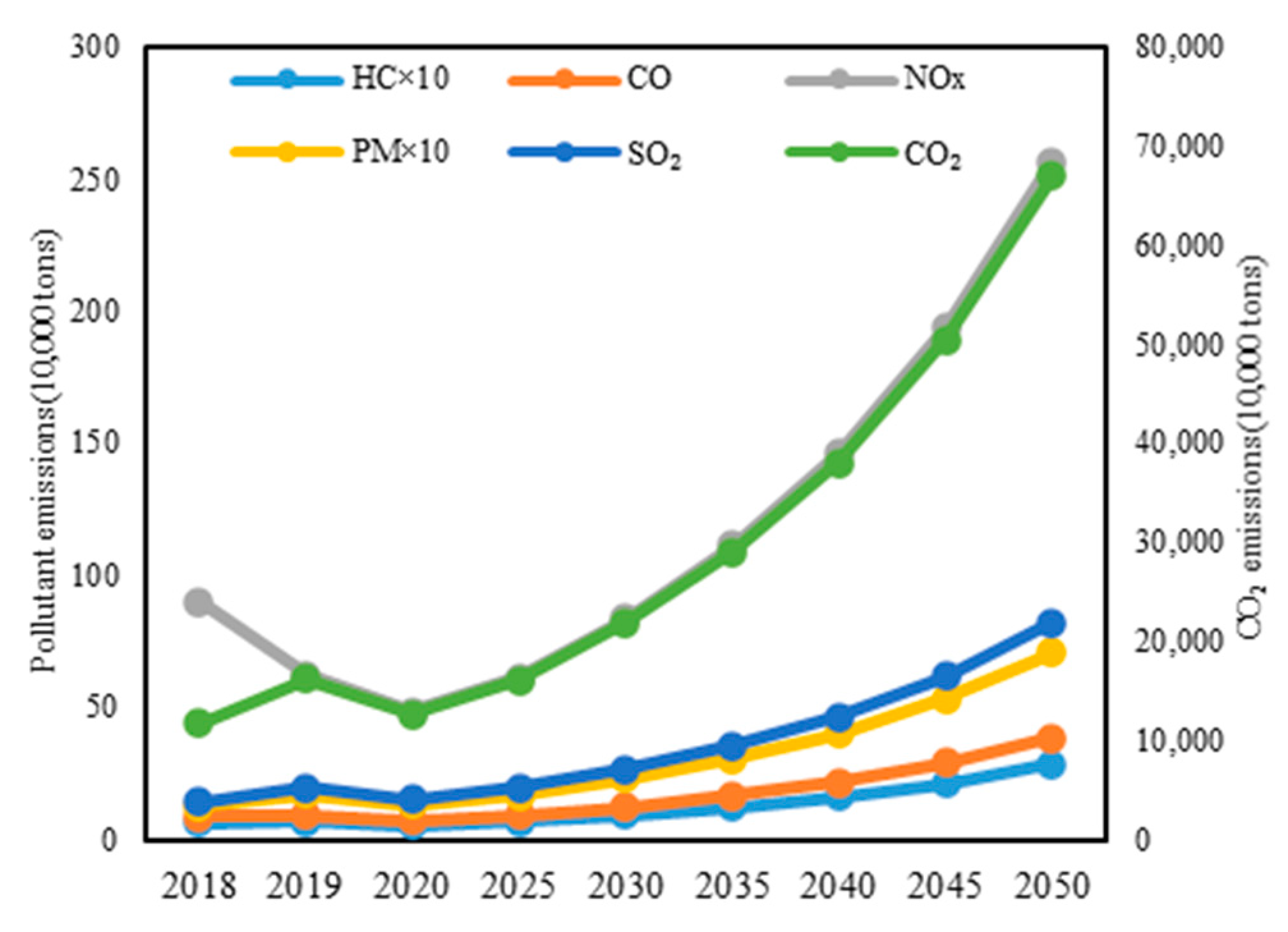


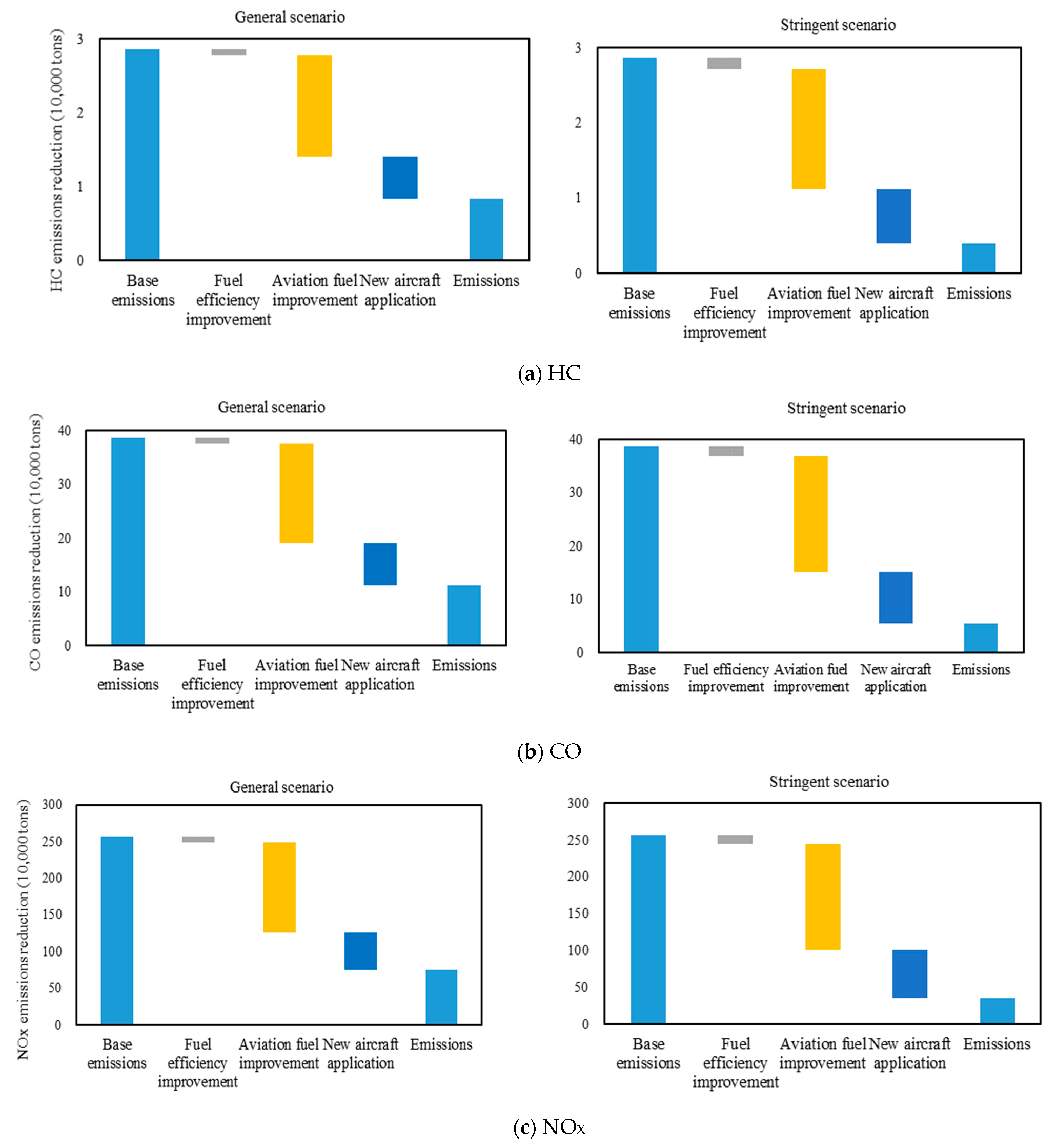
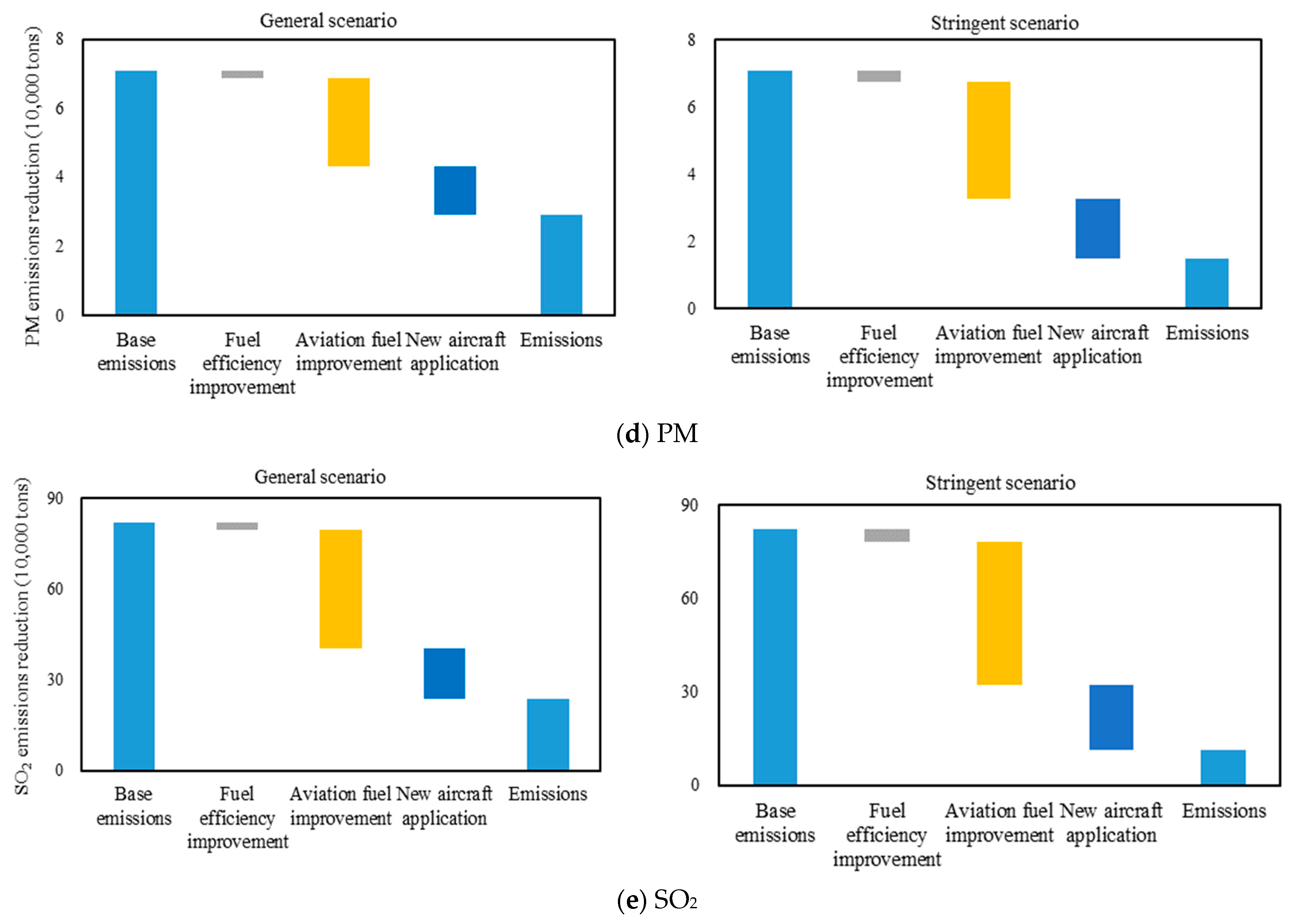

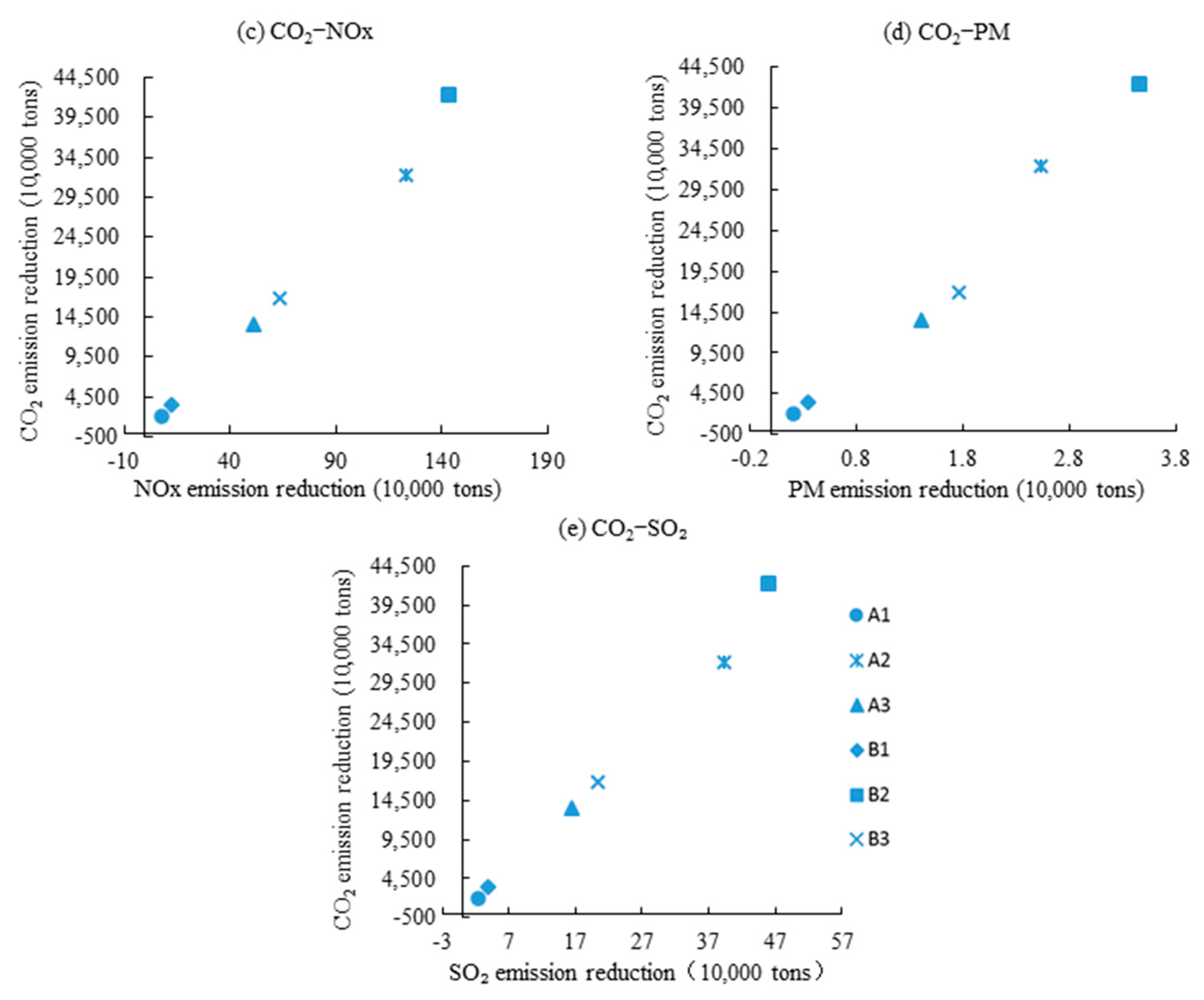
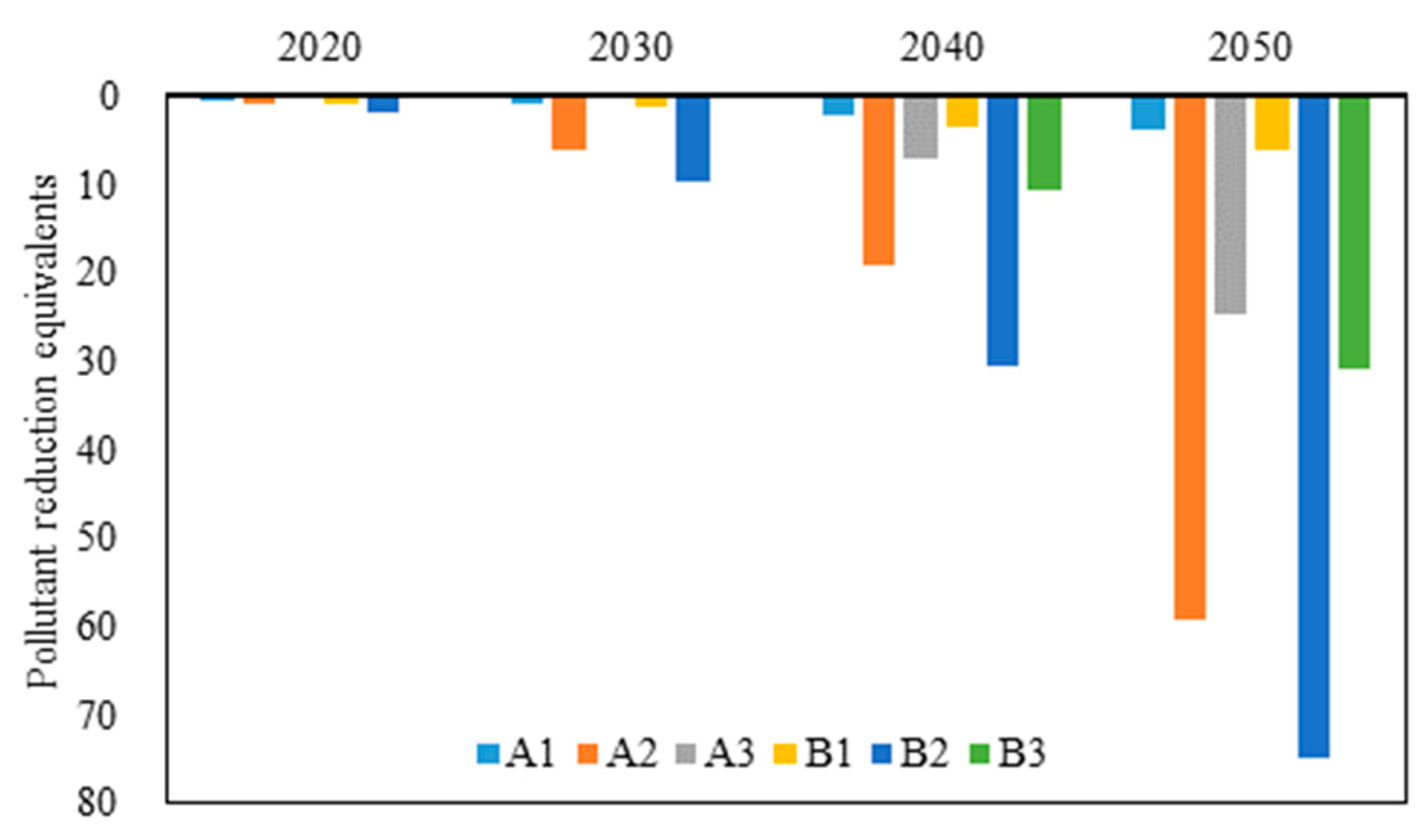
| Year | 2019 | 2020 | 2021 | 2022–2024 | 2025–2029 | 2030–2034 | 2035–2039 | 2040–2050 |
|---|---|---|---|---|---|---|---|---|
| Average annual growth rate of RPK (%) a | 6.9 | 3.78 | 3.78 | 3.78 | 6.22 | 5.71 | 5.42 | |
| Average annual growth rate of LTO (%) | 5 | −22 | 3.7 | 4.48 | 6.44 | 5.9 | 5.68 | 5.8 |
| CO2 | NOx | SO2 | CO | PM | HC | |
|---|---|---|---|---|---|---|
| Emissions | 11,723.30 | 90.47 | 14.37 | 9 | 1.29 | 0.66 |
| Scenarios | CO2 | NOx | SO2 | CO | PM | HC |
|---|---|---|---|---|---|---|
| Baseline scenario | 66,388.89 | 254.32 | 81.39 | 38.41 | 7.01 | 2.84 |
| General scenario | 19,447.25 | 74.50 | 23.84 | 11.25 | 2.90 | 0.83 |
| Stringent scenario | 4694.16 | 35.96 | 11.51 | 5.43 | 1.49 | 0.40 |
Disclaimer/Publisher’s Note: The statements, opinions and data contained in all publications are solely those of the individual author(s) and contributor(s) and not of MDPI and/or the editor(s). MDPI and/or the editor(s) disclaim responsibility for any injury to people or property resulting from any ideas, methods, instructions or products referred to in the content. |
© 2023 by the authors. Licensee MDPI, Basel, Switzerland. This article is an open access article distributed under the terms and conditions of the Creative Commons Attribution (CC BY) license (https://creativecommons.org/licenses/by/4.0/).
Share and Cite
Guo, X.; Ning, C.; Shen, Y.; Yao, C.; Chen, D.; Cheng, S. Projection of the Co-Reduced Emissions of CO2 and Air Pollutants from Civil Aviation in China. Sustainability 2023, 15, 7082. https://doi.org/10.3390/su15097082
Guo X, Ning C, Shen Y, Yao C, Chen D, Cheng S. Projection of the Co-Reduced Emissions of CO2 and Air Pollutants from Civil Aviation in China. Sustainability. 2023; 15(9):7082. https://doi.org/10.3390/su15097082
Chicago/Turabian StyleGuo, Xiurui, Chunxiao Ning, Yaqian Shen, Chang Yao, Dongsheng Chen, and Shuiyuan Cheng. 2023. "Projection of the Co-Reduced Emissions of CO2 and Air Pollutants from Civil Aviation in China" Sustainability 15, no. 9: 7082. https://doi.org/10.3390/su15097082
APA StyleGuo, X., Ning, C., Shen, Y., Yao, C., Chen, D., & Cheng, S. (2023). Projection of the Co-Reduced Emissions of CO2 and Air Pollutants from Civil Aviation in China. Sustainability, 15(9), 7082. https://doi.org/10.3390/su15097082







